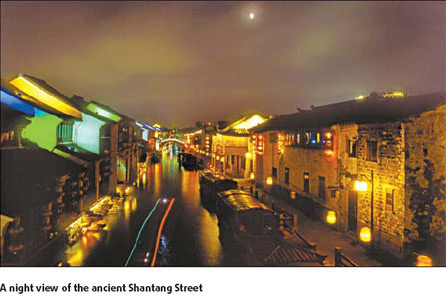| Tools: Save | Print | E-mail | Most Read |
| Renovation Project Brings Suzhou's History to Life |
| Adjust font size: |
A huge renovation project is turning the Shantang area in
The area includes a riverbank, the ancient The fame of Shantang dates back to 825 AD, when renowned statesman and poet Bai Juyi during the Tang Dynasty (618-907 AD) launched a 3,600-meter long embankment project in the area. Since then, the area has become home to many temples, guild houses, gardens and bridges, making the area a historical corridor of the city. The glamour of the area lasted for more than 1,000 years, till the end of the Qing Dynasty (1644-1911), when successive wars led to a state of decay, leaving only some ruins of steles and memorial arches in the area. But things are changing in this new millennium, with the Restoration Under the project, many places of historical interest will be renovated and rebuilt, aiming to restore the area's ancient glamor. The renovation project spans a total length of 3,600m, from Renovation of ancient residential buildings is the focus of the project. Under the principle of "renovation according to the ancient state," local authorities have drafted a scientific and detailed action plan based on field surveys and suggestions of experts and the public. They have selected a workforce with rich experience in ancient building renovation to implement the project. About 2 million yuan worth of ancient building materials were purchased for the project. With the completion of such facilities as power supply, telecommunications, cable TV, water supply, sewage and rainwater pipelines over the past two years, people now no longer have to see overhead cables or sewage being directly discharged into the rivers. Along with the renovation project, a series of documents introducing the historical and cultural attractions of the area are also being published, giving people further insight into Shantang's millennium-long history. Tourism destination Finding a way to reasonably utilize the historical resources and make the area a major tourism destination are major concerns of local authorities. The rich historical and cultural heritage and the typical water town landscape featuring bridges and rivers are attractive aspects of Shantang. Relying on such advantages, the area is expected to become a holiday destination combining touring and relaxation. Renovation of a number of places of historical interest has so far been completed, including the former residence of Wu Yipeng, the The former residence of Wu Yipeng, a high-ranking official of the Ming Dynasty (1368-1644), has now been converted into Shantang's cultural and historical museum. There is an embroidery studio, displaying the best of The The Dingzhou Guild House has now been converted into the The Ancient Theater Stage is a place that tourists can enjoy Kunqu, Pingtan and other local folk dance and opera performances. The eastern part of the ancient Besides these places of historical interest, a number of relaxation facilities have also been built in the area. For example, tourists can spend some leisure hours at the teahouses, cafes and bars near the (
|
| Tools: Save | Print | E-mail | Most Read |
 |
| Related Stories |
|
Product Directory China Search |
Country Search Hot Buys |
